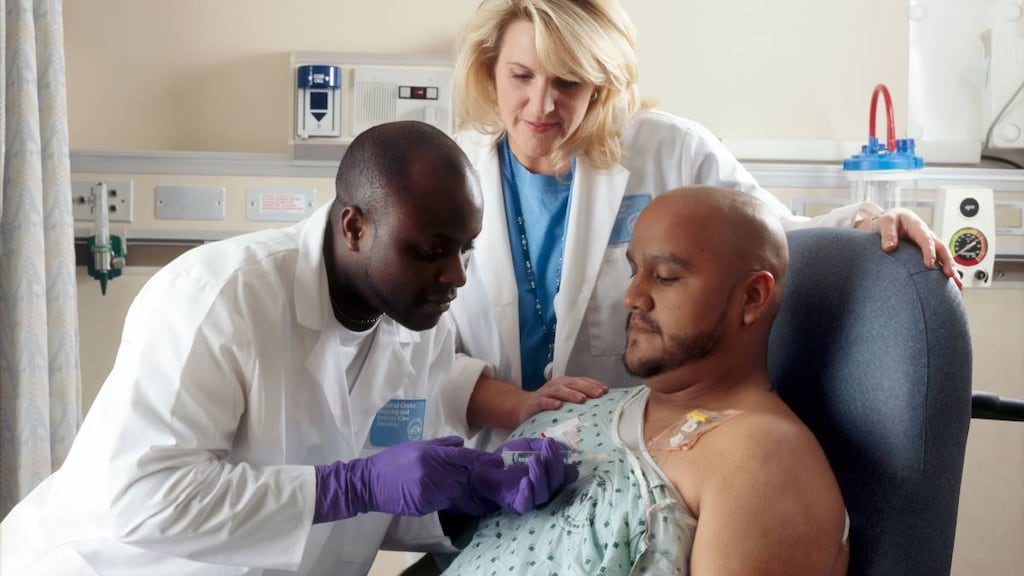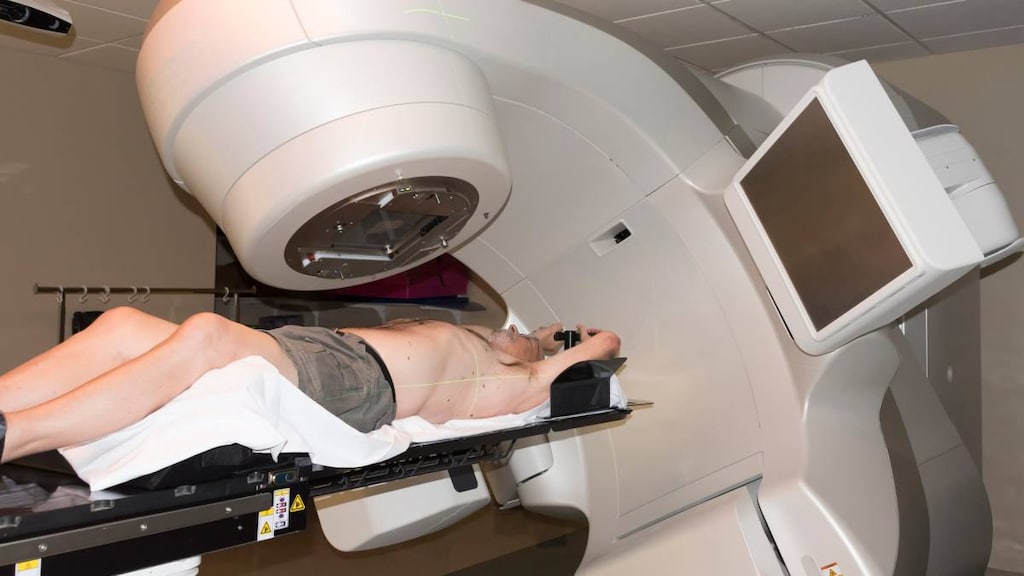Stage 4 Prostate Cancer: Survival Rates, Treatment and Support

Prostate cancer is in stage 4 when the cancer spreads beyond the lymph nodes and into other areas of the body. While the vast majority of prostate cancer cases are caught before this happens, when the cancer is treatable, stage 4 is far more difficult to treat. Therefore, the survival rate among men with stage 4 prostate cancer is much lower.
There are two types of stage 4 prostate cancer: 4A and 4B, according to the American Cancer Society. The type assigned to a person’s diagnosis is based on whether the cancer has spread and to what degree, and the value assigned to two additional factors called the Grade Group and the prostate-specific antigen (PSA). The Grade Group is a measure of how likely the cancer is to spread quickly, and the PSA is a measure of a protein in the blood produced by cells in the prostate.
With stage 4A, the tumor has already spread into the lymph nodes and may be spreading into tissues adjacent to the prostate, but has not spread to other areas of the body. The Grade Group can be of any value, as can the PSA.
With stage 4B, the tumor may have spread into the lymph nodes, may be spreading into nearby tissues and has spread to other areas of the body like the bones, certain organs and distant lymph nodes. The Grade Group and PSA can be of any value.
Life expectancy and survival rates
Generally speaking, the earlier prostate cancer is detected, the more likely treatment will be successful. Once the cancer has begun to spread outside the prostate, treatment is likely to shift away from attempts to cure the disease (it cannot be cured at this stage) and toward methods to help reduce the rate of spread, lengthen life and keep the symptoms under control, according to UCLA Health.
Unlike most prostate cancer diagnoses, for which the five-year survival rate is nearly 100 percent, the five-year survival rate for prostate cancer in the advanced stages may be less, depending on where the cancer has metastasized to. For instance, with regional metastasis (meaning the cancer has spread to nearby lymph nodes, muscles or organs), the five year survival rate is nearly 100 percent, but distant metastasis (meaning the cancer has spread to areas of the body beyond the pelvis), has a five-year survival rate of just 30 percent, according to the National Cancer Institute’s Surveillance, Epidemiology and End Results (SEER) database.
The stage of the disease at diagnosis is a better predictor of survival than age is. Studies of age as a predictor of survivability have been inconsistent. An analysis of data, published in the journal Urology in December 2014, noted that some research has shown higher rates of survival among younger patients while other research has indicated that younger men typically develop prostate cancer that is aggressive, advanced and quickly fatal.
For example, researchers writing in an April 2016 article in Bulletin Suisse du Cancer reported a 10-year survival rate of 90 percent among men younger than 80 with the disease limited to the prostate and surrounding tissues, while the survival rate of those 80 and older was just 50 percent. But an analysis based on the SEER database, published in the journal Cancer in October 2010, found that younger men with prostate cancer had an overall better prognosis, but those with high-grade and locally advanced prostate cancer had a particularly poor prognosis when compared with older men.
Treatment options
Today, stage 4 prostate cancer has no cure. However, according to the Mayo Clinic, treatments can sometimes slow the spread of the disease and prolong life. Those treatments may include:
Hormone therapy
Hormone therapy is a treatment that reduces the rate of metastasis — the spread of cancer to a different part of the body from where it started — or halts the growth of cancer that depends on hormones to grow. In men with prostate cancer, it can also be used to alleviate symptoms. Hormone therapy is sometimes referred to as hormone treatment, hormonal therapy or endocrine therapy.
In stage 4 prostate cancer, hormone therapy is often used on its own. It can also be combined with other therapies such as chemotherapy, or used following other therapies.
Chemotherapy
This treatment is used to send anti-cancer drugs throughout the body. For prostate cancer, chemotherapy may be used in conjunction with hormone therapy or if hormone therapy has not been successful. Chemotherapy is most often administered through an IV so the drug travels through the bloodstream, but in some cases it's given in pill form.
Radiation therapy
Radiation therapy is a cancer treatment that uses large doses of radiation to destroy cancer cells and reduce the size of tumors. At high doses, radiation damages the DNA of cancer cells so that they stop dividing and cannot proliferate. The treatment can take several days or many weeks before the diseased cells die. However, once cells begin to die off, this process continues for a period of weeks or months.
For men with stage 4 prostate cancer, a form of radiation called external beam radiation therapy is used. If the cancer has spread to the lymph nodes near the tumor, radiation may be combined with hormone therapy. Radiation can also be used to kill cancer cells that remain after surgery or to alleviate pain or other symptoms.
Surgery
In most cases, surgery is not used to treat stage 4 prostate cancer. When it is, it is usually done to alleviate symptoms of the cancer.
Bone treatments
If prostate cancer has spread beyond the pelvis, it often affects the man's bones and can be quite painful, according to the American Cancer Society. Medication may be used to relieve the bone pain and to keep the cancer from further growth that could lead to fractures, spinal cord compression or dangerously high levels of calcium in the blood. Drugs prescribed for this include:
- Bisphosphonates, such as zoledronic acid (Zometa)
- Denosumab (Xgeva), which is not a bisphosphonate but acts in a similar way
- Corticosteroids
- Radiopharmaceuticals, which contain radioactive elements. Options include radium-223 (Xofigo), strontium-89 (Metastron) and samarium-153 (Quadramet).
Proactive steps you can take
Diet and Exercise
According to the Prostate Cancer Foundation, a few minor changes to eating habits can be helpful for those dealing with the effects of prostate cancer. The organization recommends incorporating vegetables into many of your meals and minimizing fat intake from red meat and dairy products. The group also recommends getting vitamins from food sources like whole grains and vegetables as opposed to vitamin supplements. It is particularly important to get calcium from food sources, namely dark green leafy vegetables and low-fat dairy foods.
Coping and support
If you or a loved one has prostate cancer, it's important to remember that you are not alone: More than 150,000 men are diagnosed with prostate cancer every year, according to the Prostate Cancer Foundation.
Still, it is normal for men diagnosed with prostate cancer to feel alone, uncertain or fearful. Support groups are an excellent resource for men with prostate cancer, providing a community with whom to share encouragement, information and emotional support. These groups range from online communities with people who can help answer questions to groups of men diagnosed with prostate cancer or family members of those diagnosed. They are sometimes facilitated by mental health professionals and experts in the field of prostate cancer.
Palliative care
This refers to care aimed at providing relief from pain and other symptoms of disease. It also aims to provide emotional, practical and spiritual support. And it provides support for family members and others assisting those with serious diseases.
Palliative care may be provided at any stage of advanced disease. It is not limited to men in the last weeks or days of their lives, but does include end-of-life care. A man with advanced prostate cancer may receive palliative care for months or even years.
Palliative care can include any of the following:
- Treatment and management of pain and other symptoms
- Discussion of symptoms and emotions
- Discovering ways to cope with your illness
- Relaxation methods such as massage
- Social groups to help with quality of life and feelings of isolation
- Assistance with financial and practical support
- Support for family members and others
Palliative care can occur in various settings, such as the hospital or your own home. Support groups also sometimes fall under the umbrella of palliative care. The setting depends on your needs and desires. If you are not yet interested in having palliative care, it’s still a good idea to learn about the options in case your feelings change in the future. To learn more, speak with your doctor about what types of palliative care may be available.
Article references
- 1. Healthwise, Cancer Staging and Grading https://www.uofmhealth.org/health-library/abn1258
- 2. American Cancer Society, Prostate Cancer Stages and Other Ways to Assess Risk https://www.cancer.org/cancer/prostate-cancer/detection-diagnosis-staging/staging.html
- 3. Johns Hopkins Medicine, Prostate Cancer Prognosis https://www.hopkinsmedicine.org/health/conditions-and-diseases/prostate-cancer/prostate-cancer-prognosis
- 4. UCLA Health, Advanced Prostate Cancer https://www.uclahealth.org/urology/prostate-cancer/advanced-prostate-cancer-treatment
- 5. American Cancer Society, Treating Prostate Cancer https://www.cancer.org/cancer/prostate-cancer/treating.html
- 6. Urology, Recent Time Trends in the Epidemiology of Stage IV Prostate Cancer in the United States: Analysis of Data From the Surveillance, Epidemiology, and End Results Program. December 2014 https://www.ncbi.nlm.nih.gov/pmc/articles/PMC4249683/
- 7. National Institute for Epidemiology and Registration (Switzerland), Effects of age and stage on prostate cancer survival in Switzerland https://www.nicer.org/assets/files/publications/others/skb_04-2016_effectsprostatecancerch.pdf
- 8. Cancer, Treatment and survival outcomes in young men diagnosed with prostate cancer: a population based cohort study https://www.ncbi.nlm.nih.gov/pmc/articles/PMC2948666/
- 9. Mayo Clinic, Stage 4 prostate cancer https://www.mayoclinic.org/diseases-conditions/stage-4-prostate-cancer/diagnosis-treatment/drc-20377972
- 10. Prostate Cancer Foundation, Prostate Cancer Diet https://www.pcf.org/patient-resources/living-prostate-cancer/prostate-cancer-diet/
- 11. Prostate Cancer Foundation, Support Groups https://www.pcf.org/patient-resources/patient-navigation/support-groups/
- 12. Prostate Cancer UK, Thinking and planning ahead https://prostatecanceruk.org/prostate-information/advanced-prostate-cancer/dying-from-prostate-cancer/thinking-and-planning-ahead
- 13. National Cancer Institute: Surveillance, Epidemiology and End Results Program. "Cancer Stat Facts: Prostate Cancer" https://seer.cancer.gov/statfacts/html/prost.html




